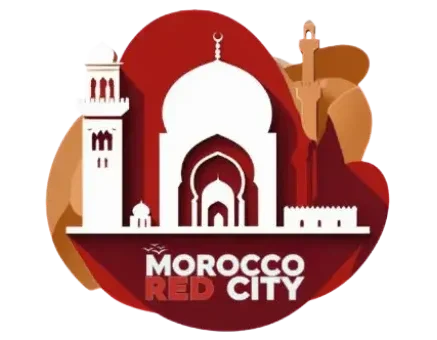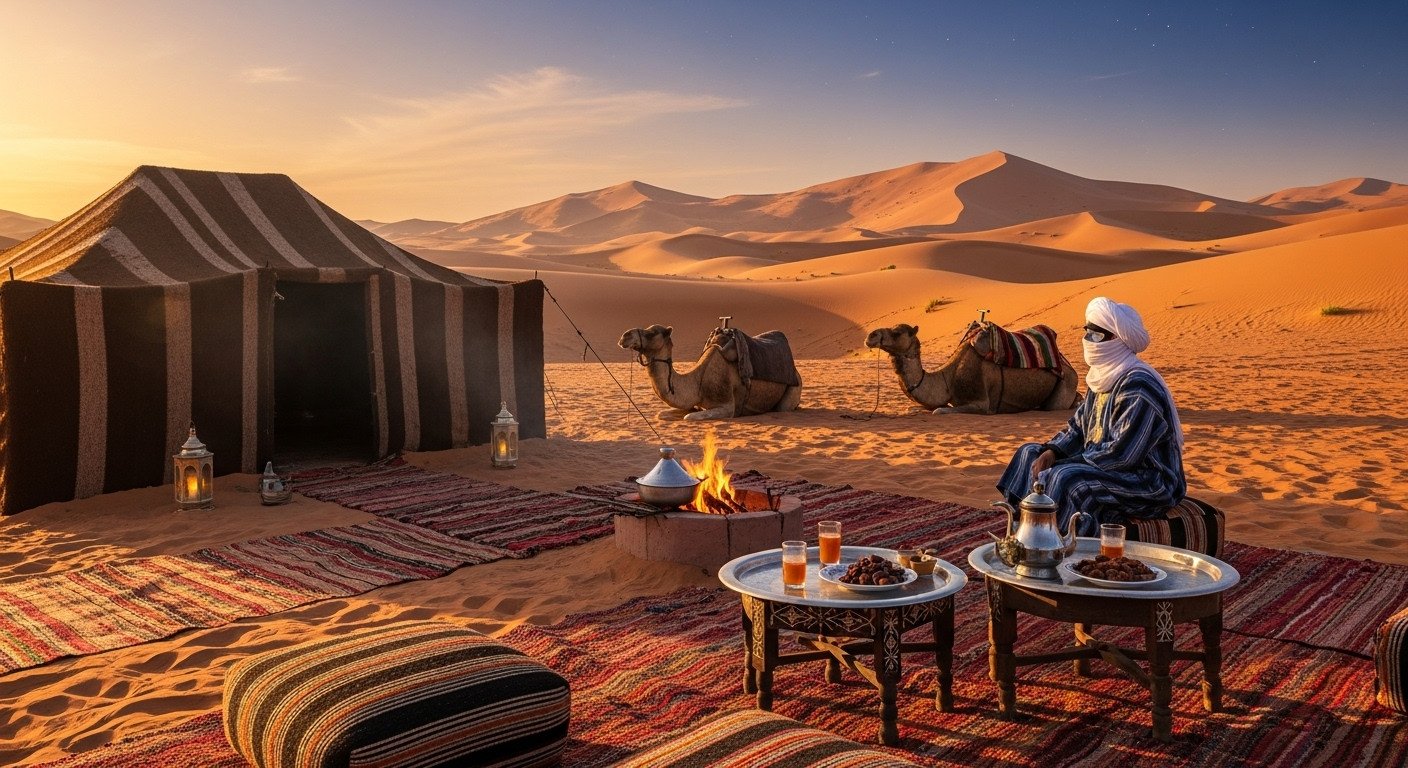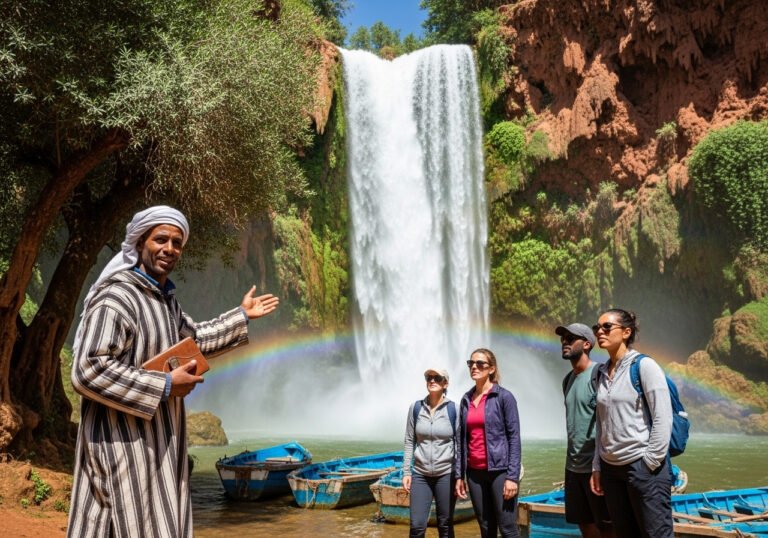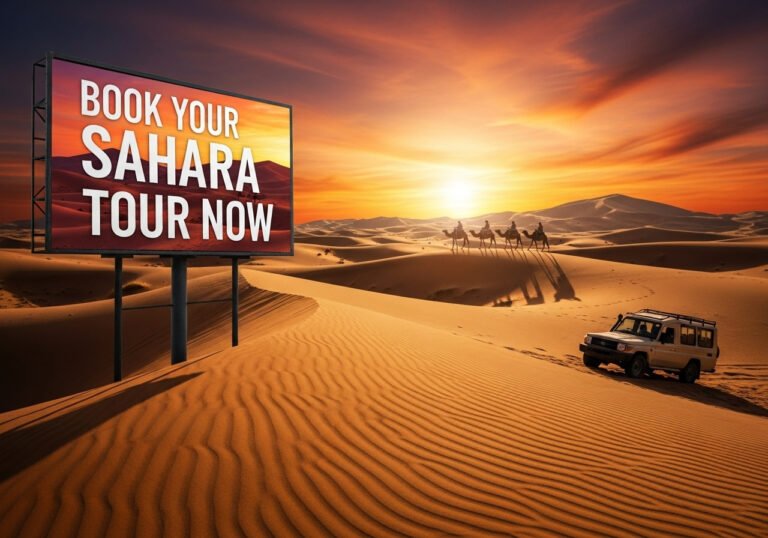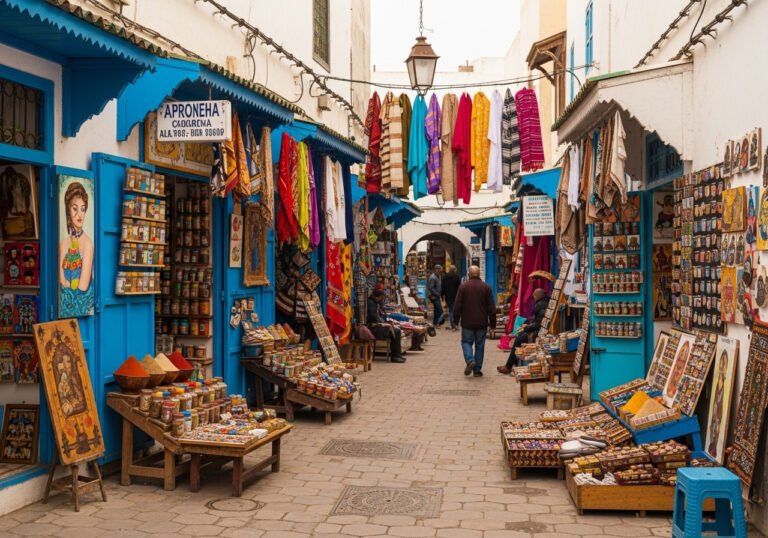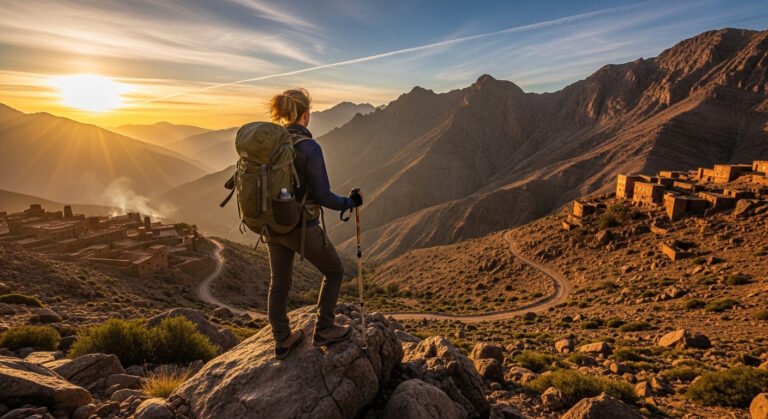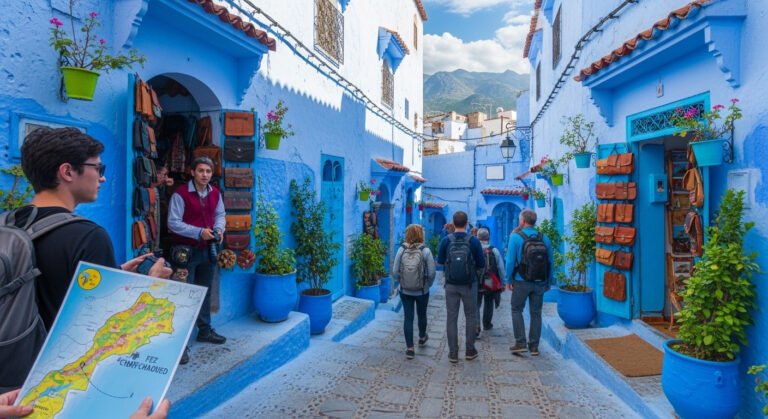Camping in the Moroccan Sahara – Best Desert Experiences in 2025
Let’s be real — camping in the Moroccan Sahara sounds like one of those bucket-list adventures you dream about but secretly wonder if it’s actually worth the hype. I mean, you’ve seen the photos: golden dunes, camels marching in perfect lines, starry skies so clear you could cry. But what’s it really like?
Spoiler: it’s magical. Also dusty, slightly chaotic, and absolutely unforgettable.
If you’re thinking about heading into the dunes, you’ll quickly bump into the age-old traveler debate: Merzouga vs Erg Chigaga. Which one’s better? And how do you avoid overpaying or getting stuck on a sketchy tour?
Don’t worry — I’ve got you. Here’s the full, honest, no-BS guide to camping in Morocco’s Sahara, how to book smart, and what you’ll actually experience once you’re there.
Why Everyone Should Try Camping in the Moroccan Sahara (At Least Once)
There’s something about the Sahara that gets under your skin — in a good way (and yes, sometimes literally, because sand gets everywhere). The desert stretches endlessly, glowing orange and gold, and when night falls, the stars are so bright it feels like you’ve stepped inside a planetarium.
You sit by the campfire, sip sweet mint tea, and listen to Berber drums echo through the night. It’s not just a trip — it’s a whole vibe.
But here’s the thing: planning a Sahara trip isn’t as easy as hopping in a cab. Morocco’s deserts are far — we’re talking 10–12 hours from Marrakech — and not every tour is worth your money. That’s why understanding Merzouga vs Erg Chigaga (and booking the right trip) matters big time.
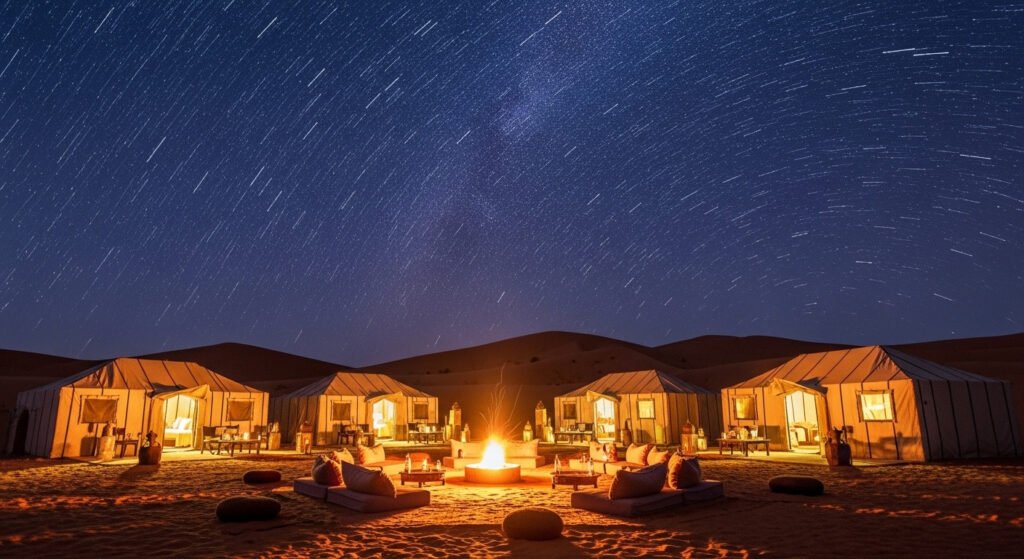
Merzouga vs Erg Chigaga — Which Sahara Experience Is Right for You?
Ah, the big desert dilemma. Morocco has two main areas where travelers go for that “Lawrence of Arabia” fantasy: Merzouga (Erg Chebbi dunes) and Erg Chigaga near M’Hamid. Both are incredible, but they deliver totally different vibes.
Let’s break it down like travel friends chatting over coffee.
Merzouga (Erg Chebbi): The Classic, Easy-to-Reach Desert
If you want that picture-perfect Sahara moment — the huge orange dunes, camel caravan silhouettes, and luxury tents with fairy lights — then Merzouga is your spot.
It’s the more developed area, meaning you’ll find everything from budget camps to full-blown glamping setups with hot showers and Wi-Fi (yes, Wi-Fi in the desert — wild).
Why it’s great:
- You can get there on paved roads from Marrakech or Fes — super easy compared to the off-road adventure of Chigaga.
- The dunes here are massive, some reaching 160 meters tall. Great for dramatic sunrise shots or pretending you’re in The Mummy.
- Perfect for first-timers or anyone doing a quick 3-day Sahara tour.
The vibe:
Comfortable, accessible, slightly touristy — but still jaw-dropping. It’s like the “Disneyland” version of the Sahara… in the best possible way.
Erg Chigaga: The Remote, Wild, Adventure-Only Option
Now, if you’re the kind of traveler who prefers wilderness over Wi-Fi and adventure over convenience, then Erg Chigaga will steal your heart.
To get there, you’ll travel through M’Hamid, then spend about 60 km bumping along in a 4×4 — no paved roads, no signal, just dunes and silence.
Why it’s epic:
- It’s the largest dune system in Morocco, stretching over 40 km wide. You’ll barely see another soul.
- The sunsets here? Unreal. The stars? Even better.
- It’s as authentic as desert life gets — fewer crowds, fewer comfort perks, but way more soul.
The catch:
It’s remote, rough, and not ideal for short trips. Plan at least a 3-day Erg Chigaga adventure (or four, if you want to take it slow).
The vibe:
Wild, raw, and peaceful. You’ll trade luxury for silence — and honestly, it’s totally worth it.
Planning Your Sahara Adventure (Without Losing Your Sanity)
Okay, now that you know where to go, let’s talk logistics — aka the not-so-glamorous but super important stuff.
How Long Should You Stay?
Here’s the truth: a Sahara trip isn’t a quick detour.
- 3 days is the bare minimum — one full day of driving each way, plus one magical night in the dunes.
- 4 days or more gives you breathing room to explore without spending half the trip in a van.
Skip any “2-day Sahara tour” you see online. Those go to Zagora or Agafay, which are rocky, not sandy. They’re nice, but not that Sahara you’ve been dreaming of.
The Best Routes to Take
- Marrakech → Merzouga (Round Trip): The most popular. You’ll loop back to Marrakech after your desert night.
- Marrakech → Fes (One Way): My favorite! You’ll see the High Atlas Mountains, Ait Ben Haddou, Dades Gorge, and end up in Fes — perfect if you’re continuing north.
- Independent Travel: For the bold and budget-savvy. You can take buses to Ouarzazate, Tinghir, then Merzouga, but be ready to plan every connection yourself.
Booking the Right Trip — Don’t Fall for Desert Scams
Here’s where a lot of travelers mess up. You’ll walk through Marrakech’s medina, and suddenly five guys are offering you a “best desert trip, my friend, very cheap!”
Tempting? Maybe.
Smart? Nope.
Here’s why: those cheap tours (think $70–$120) often cut corners big time. Old vans, bad food, shady camps, and guides who pressure you into buying stuff you don’t need.
Why Booking in Advance Is 100% Worth It
Honestly, the best move is booking the right trip in advance with a reputable company. Platforms like GetYourGuide or local agencies with tons of reviews are your safest bet.
Why?
- You can read real reviews and see what you’re paying for.
- There’s customer protection if something goes wrong.
- Reputable companies have standards — they actually care about your experience.
Pro tip: look for tours with thousands of reviews, clear itineraries, and free cancellation.
What to Expect Based on Budget
- Budget Tours ($120–$180): Great for backpackers. Expect basic tents, shared bathrooms, and a few “mystery stops” at rug shops.
- Mid-Range ($250–$350): Best value — comfy glamping tents, private bathrooms, and better guides.
- Luxury ($500+): Total comfort. Think en-suite tents, gourmet dinners, private transfers, and maybe even AC.
Bottom line: you get what you pay for.
When’s the Best Time to Go?
Timing makes or breaks your desert trip. Here’s the quick lowdown:
Spring (March–May) & Autumn (September–November)
Perfect weather. Warm days, cool nights, and fewer crowds. You can do all the fun stuff — camel rides, sandboarding, sunset photos — without melting.
Summer (June–August): The Sahara Oven
It’s hot. Like, really hot. We’re talking 45°C (113°F) or more.
If you do go in summer, make sure your camp has shade or AC, and plan activities early in the morning or at sunset. The upside? You’ll get the best stargazing of your life.
Winter (December–February): Cold but Beautiful
Days are mild and sunny, but nights are freezing. Pack warm layers — thermals, socks, maybe even a down jacket. Camps provide blankets, but extra layers never hurt.
What No One Tells You About Camping in the Sahara
Time for some real talk. The desert is amazing, but it’s not all Instagram glam. Here’s what most guides forget to mention:
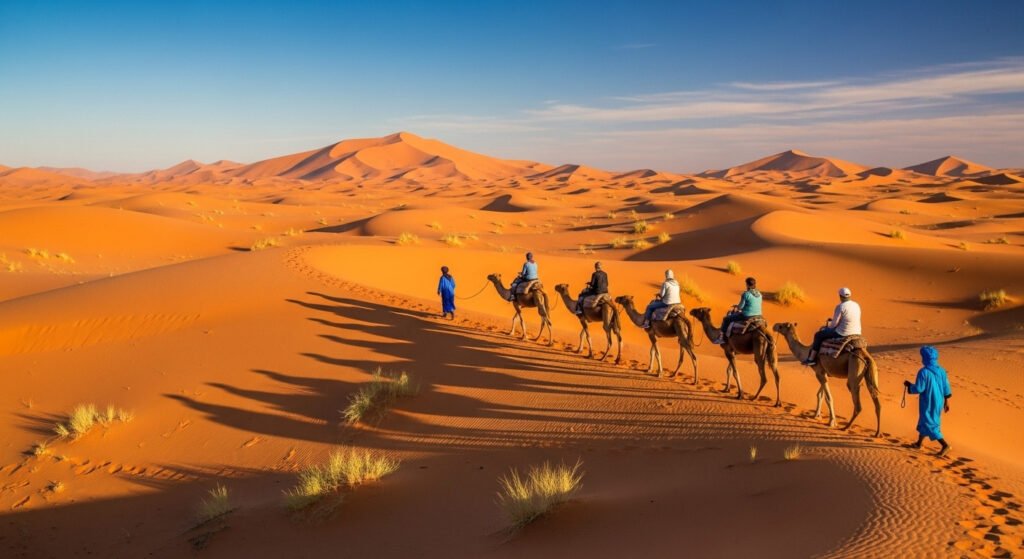
Camel Trekking Hurts (a Little)
Riding a camel looks cool on Instagram… until 20 minutes in. They’re not exactly built for comfort. Expect sore thighs and wobbly legs afterward.
If you have back or hip issues, ask your guide if a 4×4 or ATV option is available.
Expect “Surprise” Shopping Stops
Most tours stop at rug shops, “traditional” restaurants, or scarf stalls. It’s part of the deal — guides earn commission. Just smile, browse, and don’t feel pressured to buy.
Bring extra cash (around $100) for food, water, and small tips.
Motion Sickness Is Real
The road through the Atlas Mountains is full of twists. If you get carsick easily, bring Dramamine or Sea Bands. Trust me, you’ll thank yourself later.
Solo Female Travelers — Be Extra Careful
Morocco is generally safe, but solo women can face unwanted attention. Always book well-reviewed tours and read recent feedback from other female travelers.
Stick to group tours or private guides with solid reputations — your comfort matters.
Beyond the Dunes — The Road Trip Gems You’ll Pass
The drive to the Sahara is long, but it’s packed with jaw-dropping stops that make the journey totally worth it:
- Ait Ben Haddou: The Insta-famous clay fortress from Game of Thrones and Gladiator.
- Todra Gorge: Giant red cliffs and a river — perfect for stretching your legs after the long drive.
- Ouarzazate: Morocco’s “Hollywood,” home to Atlas Film Studios.
- Dades Gorge: Famous for the twisty road and “Monkey Fingers” rock formations.
- High Atlas Mountains: Snow-capped peaks, winding passes, and a dozen photo ops.
Quick FAQ — Straight Answers, No Fluff
Is it safe to camp in the Moroccan Sahara?
Totally — just go with a good company. Avoid wandering off solo.
How long’s the drive from Marrakech to the Sahara?
About 10–12 hours one way. Bring snacks and playlists.
Best way to get there?
Join a guided tour. Self-driving is possible but long and tiring.
Best time to visit?
Spring or autumn — warm days, cool nights, no sandstorms.
Do desert camps have bathrooms?
Budget ones might not. Luxury ones? Think full-on hotel bathrooms.
What should I pack?
Loose clothes, a scarf, sunscreen, warm layers, cash, and motion sickness meds.
Final Thoughts — Don’t Overthink It, Just Go
Here’s the deal: camping in the Moroccan Sahara isn’t just another travel experience — it’s one of those “wow, I’ll never forget this” moments.
Sure, the journey’s long. Yes, sand gets in your shoes. But when you’re sitting by a fire under a billion stars, hearing drums echo across the dunes, you’ll realize it was worth every single mile.
Whether you choose Merzouga for comfort or Erg Chigaga for wild adventure, the Sahara will leave a mark on your soul.
So go ahead — start booking the right trip, maybe a 3-day Erg Chigaga tour if you’re up for a real adventure. The desert’s calling… and trust me, you’ll want to answer. 🌵✨
